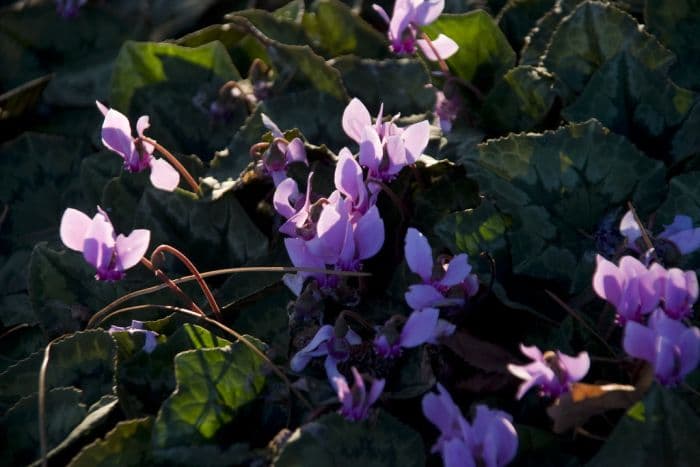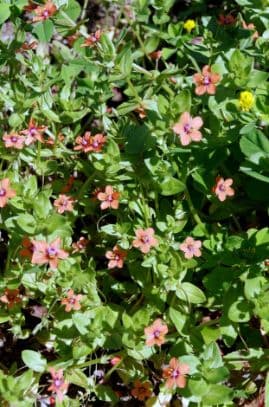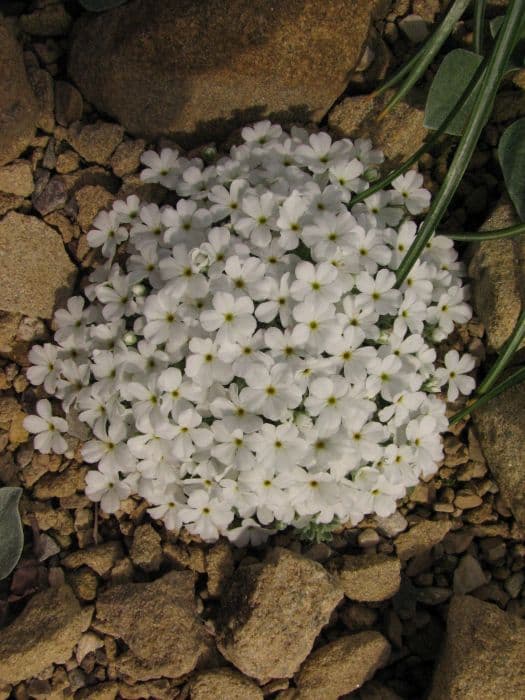Lebanese Cyclamen Cyclamen libanoticum

ABOUT
Cyclamen libanoticum, more commonly known as Lebanese cyclamen, is a striking flowering plant recognized for its unique and beautiful blooms. The flowers of Lebanese cyclamen are notable for their swept-back petals that resemble small, delicate, fluttering butterflies. Typically, the petals come in shades ranging from white to pale pink, often with a magenta or purple blotch at the base. The heart-shaped leaves are another attractive feature, being dark green in color with a marbled, silvery-white patterning on the surface that adds to the ornamental value of the plant. Lebanese cyclamen produces flowers that rise above the foliage on slender stalks, giving the appearance that the blooms are gracefully hovering or dancing above the leaves. The contrast between the dark green of the leaves and the brighter colors of the flowers creates a visually appealing display. The overall form of the plant is compact and rounded, with a basal rosette arrangement of the leaves, creating a tidy and contained appearance that makes it suitable for growing in small pots or garden spaces where it can be appreciated up close. The leaves typically show some degree of curling or twisting, which adds to the textured look of the plant. Overall, Cyclamen libanoticum is celebrated by gardeners and plant enthusiasts for its enchanting flowers and leaves, which bring a touch of natural beauty and elegance wherever it is grown.
About this plant
 Names
NamesFamily
Primulaceae
Synonyms
Lebanon Cyclamen
Common names
Cyclamen libanoticum.
 Toxicity
ToxicityTo humans
Cyclamen is generally considered toxic if ingested. The plant contains compounds such as saponins, which can cause symptoms of poisoning in humans. If any part of a cyclamen plant is ingested, common symptoms may include nausea, vomiting, and diarrhea. In severe cases, ingestion can also lead to heart rhythm abnormalities, seizures, and even death, especially if large amounts are consumed. It is important to keep this plant out of reach of children and to be aware of its toxic nature.
To pets
Cyclamen is also toxic to pets, including both cats and dogs. The toxic principles, primarily saponins, can cause symptoms such as vomiting, diarrhea, and salivation if ingested. In severe cases, ingestion can lead to heart problems, seizures, and even death. It is especially important to prevent pets from accessing and chewing on any part of the plant, as they may be more likely to suffer severe reactions due to their smaller body size compared to humans.
 Characteristics
CharacteristicsLife cycle
Perennials
Foliage type
Evergreen
Color of leaves
Varies
Flower color
Pink
Height
0.16 feet (5 cm)
Spread
0.16 feet (5 cm)
Plant type
Bulb
Hardiness zones
7
Native area
Lebanon
Benefits
 General Benefits
General Benefits- Aesthetic appeal: Cyclamen libanoticum, or Lebanese cyclamen, features attractive heart-shaped leaves and vibrant flowers that enhance the visual appeal of gardens and indoor spaces.
- Seasonal interest: The plant blooms in late winter to early spring, providing color during a season when few other plants are in bloom.
- Pollinator attractor: Lebanese cyclamen flowers can attract pollinating insects, supporting local biodiversity.
- Compact growth: Suitable for small garden spaces, balconies, and indoor containers due to its compact size.
- Low maintenance: Once established, it requires minimal care beyond regular watering and occasional feeding, making it suitable for busy or novice gardeners.
- Drought tolerance: Lebanese cyclamen can tolerate periods of dryness once mature, which can be beneficial in water-scarce environments.
 Medical Properties
Medical PropertiesThis plant is not used for medical purposes.
 Air-purifying Qualities
Air-purifying QualitiesThis plant is not specifically known for air purifying qualities.
 Other Uses
Other Uses- Cyclamen libanoticum bulbs can be ground up and used as a laundry starch for stiffening clothes due to their glutinous nature.
- The petals of Cyclamen libanoticum may be used as a natural dye for fabrics, providing a subtle color derived from its pigments.
- The plant can be used in potpourri or dried flower arrangements for its aesthetic appeal even after the blooms have faded.
- Crushed leaves of Cyclamen libanoticum can sometimes serve as an ingredient in traditional perfumes, contributing a green, earthy note to the fragrance.
- Cyclamen libanoticum seed oil, extracted from its seeds, has been used in cosmetics for its moisturizing properties.
- Juice from the stems may also be used as an insect repellent for its natural compounds that certain insects might find unattractive.
- The plant's distinct foliage can be used in landscape design to create texture contrasts in gardens, without relying on its flowers.
- Pressed Cyclamen libanoticum flowers can be used in crafting and scrapbooking to decorate various paper goods and keepsakes.
- Floral artists may use Cyclamen libanoticum as a living sculpture element due to its unique flower shape and foliage.
- The thick leaves can serve as a natural mulch, decomposing over time to enrich the soil with organic matter.
Interesting Facts
 Feng Shui
Feng ShuiThe Cyclamen is not used in Feng Shui practice.
 Zodiac Sign Compitability
Zodiac Sign CompitabilityThe Cyclamen is not used in astrology practice.
 Plant Symbolism
Plant Symbolism- Love and Devotion: Cyclamen, commonly representing love, is often associated with deep and lasting affection. Its resilient nature symbolizes enduring love and devotion between individuals.
- Sincerity and Innocence: The simplicity of the cyclamen's flowers is commonly thought to express sincere feelings and innocence in a relationship.
- Farewell and Parting: In some cultures, cyclamen is given as a farewell gift, signifying a wish for positive new beginnings as it often goes dormant only to bloom again with the next season, symbolizing renewal and future reunions.
- Resilience and Strength: The ability of cyclamen to thrive in rocky and challenging environments is emblematic of a person's inner strength and the capacity to persevere through tough circumstances.
 Water
WaterCyclamen (most commonly referred to as Persian cyclamen) requires moderate watering during its growing season, which is fall through spring. It should be watered when the top inch of soil feels dry to the touch, typically about once a week, depending on the environmental conditions. Use lukewarm water, and irrigate from below to avoid wetting the foliage and crown, which can lead to fungal diseases. Carefully pour approximately 8-16 ounces of water per watering session, ensuring to never leave the plant sitting in water as this can cause root rot. During its summer dormancy, reduce watering significantly, providing just enough to keep the tuber from completely drying out.
 Light
LightCyclamen prefers bright, indirect light and should be placed in a location where it can receive such light, such as an east-facing window or a spot that is shaded during the hottest part of the day. Direct sunlight, especially during summer, can scorch the leaves, whereas too little light can result in weak growth and fewer blooms. A north-facing window can also be adequate if the light is sufficiently bright. Do not place the cyclamen in deep shade or overly dark areas, as this can hinder its flowering potential.
 Temperature
TemperatureCyclamen enjoys cool temperatures and thrives best in a range of 50-68 degrees Fahrenheit. It should not be exposed to temperatures below 40 degrees Fahrenheit to avoid damage to the plant, and it's equally important to protect it from hot temperatures above 70 degrees Fahrenheit, as excessive heat may cause the plant to go into early dormancy. The ideal temperature conditions for cyclamen are consistent, cool temperatures without drastic fluctuations, typically making it well-suited to the indoors or a cool greenhouse.
 Pruning
PruningPruning cyclamen is mostly about removing yellow or wilted leaves and spent flowers to encourage more blooms and maintain a tidy appearance. It's best done promptly when such aging plant parts are noticed. Pruning can occur at any time of the year as needed. After flowering is complete, and the leaves begin to yellow naturally, reduce watering to encourage the plant to go dormant and prune back the foliage once it has died back completely.
 Cleaning
CleaningAs needed
 Soil
SoilLebanese Cyclamen thrives in well-draining, humus-rich mix with a slightly acidic to neutral pH of 6.5 to 7. A good recipe would be equal parts of peat, loam, and perlite.
 Repotting
RepottingLebanese Cyclamen should be repotted every 1-2 years in the fall, during its dormant period, to refresh the soil and accommodate growth.
 Humidity & Misting
Humidity & MistingLebanese Cyclamen prefers moderate to high humidity, ideally between 40-70%, for optimal growth without the leaves getting too wet.
 Suitable locations
Suitable locationsIndoor
Place Lebanese Cyclamen in bright, indirect light, ensure high humidity, and moderate temperatures.
Outdoor
Plant Lebanese Cyclamen in dappled shade, sheltered from strong winds, and mulch soil.
Hardiness zone
7-9 USDA
 Life cycle
Life cycleCyclamen libanoticum, also known as Lebanese cyclamen, begins its life cycle with seed germination, which typically occurs in late spring or early summer. After germination, the seedlings develop into a tuber, which is a storage organ that enables the plant to survive adverse conditions. Each growing season, the tuber sends up a rosette of heart-shaped leaves followed by the distinctive flowers, which can range from white to pale pink with a magenta blotch at the base, usually blooming from late winter to early spring. Once pollinated, usually by insects, the flowers develop into seed pods that spiral down towards the ground as they mature. Once ripe, the seed pods release their contents, completing the cycle by potentially giving rise to new plants if the conditions are suitable. Throughout its life, the cyclamen enters a dormancy period during the hot and dry summer months, allowing it to conserve energy and resources until favorable growth conditions return.
 Propogation
PropogationPropogation time
Spring to Summer
Cyclamen libanoticum, also commonly known as Lebanon cyclamen, is typically propagated by seed. The most popular method involves sowing the seeds in a tray filled with a well-drained soil mix. To encourage germination, the seeds are usually soaked in water for 12 to 24 hours before planting. After soaking, they are sown on the surface of the soil mix and lightly covered with a fine layer of soil or vermiculite. The tray should be kept at a temperature of around 65 degrees Fahrenheit (18 degrees Celsius) and out of direct sunlight, ensuring the soil remains moist but not waterlogged. Germination can take several weeks, and once the seedlings develop their first true leaves, they can be carefully transplanted into individual pots.









